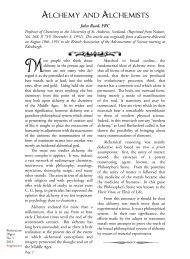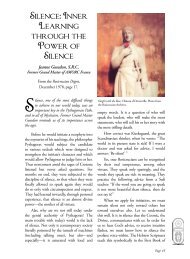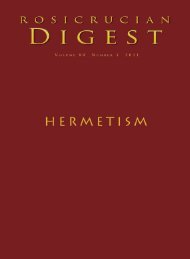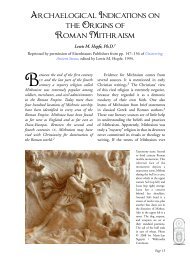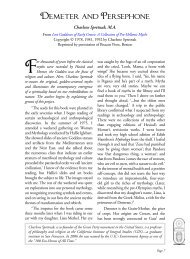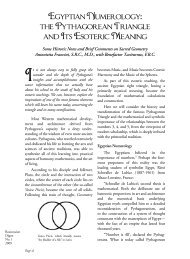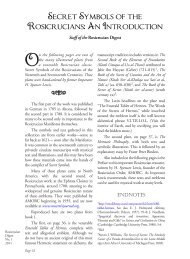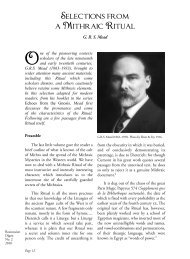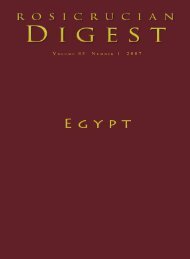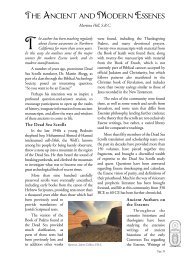Pythagorean Teachings across the Centuries - Rosicrucian Order
Pythagorean Teachings across the Centuries - Rosicrucian Order
Pythagorean Teachings across the Centuries - Rosicrucian Order
Create successful ePaper yourself
Turn your PDF publications into a flip-book with our unique Google optimized e-Paper software.
Portrait of Socrates. Roman marble, first century CE,<br />
perhaps a copy of a lost bronze statue made by Lysippos.<br />
Louvre, Paris. Photo ©2005 Eric Gaba/Wikimedia<br />
Commons.<br />
<strong>the</strong> universe and all <strong>the</strong> individual objects.<br />
Next, Plato, in his Dialogues, Theaetetus,<br />
Parmenides, etc., demonstrates <strong>the</strong> influence<br />
of <strong>the</strong> <strong>Pythagorean</strong> school, so much so, as<br />
Burnet states, that Plato established his own<br />
academy with <strong>the</strong> intention of continuing <strong>the</strong><br />
line of teachings of <strong>the</strong> <strong>Pythagorean</strong> school. 3<br />
Moved by <strong>the</strong> desire for learning <strong>the</strong><br />
secrets of this “initiatic knowledge,” Plato was<br />
not satisfied to listen to <strong>the</strong> last representatives<br />
of <strong>Pythagorean</strong>ism, who had taken refuge in<br />
Greece (some of <strong>the</strong>se, as noted before, were<br />
part of <strong>the</strong> group surrounding Socrates).<br />
Ra<strong>the</strong>r, he tried to get in touch with those<br />
more advanced on <strong>the</strong> initiatic path. From<br />
this desire arose his need, according to some<br />
authors, to investigate more deeply and more<br />
personally in those places that had been <strong>the</strong><br />
<strong>the</strong>ater of <strong>the</strong> “<strong>Pythagorean</strong> drama.”<br />
In such places <strong>the</strong> environment had<br />
preserved traces of <strong>the</strong> events and still kept<br />
<strong>Rosicrucian</strong><br />
Digest<br />
No. 1<br />
2009<br />
Given <strong>the</strong>se beginnings, though this<br />
school had been founded by Greeks, it was<br />
intended to attract <strong>the</strong> interest of Italian<br />
Peninsular peoples more than all <strong>the</strong> o<strong>the</strong>r<br />
ancient schools; however, <strong>the</strong> contrary<br />
happened in many ways. Capparelli notes<br />
that in Italy <strong>the</strong> school of Pythagoras has had a<br />
negative reputation, at least in modern times. 2<br />
Several of <strong>the</strong> <strong>Pythagorean</strong> teachings have<br />
been attributed to o<strong>the</strong>r ancient philosophers<br />
such as Plato and Aristotle. Some literary<br />
critics, and among <strong>the</strong>m, Burnet, give <strong>the</strong><br />
following explanation.<br />
<strong>Pythagorean</strong> Influence on<br />
Socrates and Plato<br />
The <strong>Pythagorean</strong>s, after being dispersed,<br />
went to Greece and regrouped around<br />
Socrates, who became <strong>the</strong>ir leader and<br />
incorporated <strong>the</strong> original teachings with <strong>the</strong><br />
following modification: <strong>the</strong> <strong>Pythagorean</strong>s<br />
assumed <strong>the</strong> “universal” to be separated from<br />
<strong>the</strong> sensible objects. Socrates denied such<br />
separation and established <strong>the</strong> harmony of<br />
Page xxiv<br />
Alexander Visits <strong>the</strong> Sage Plato. Page from a dispersed<br />
manuscript of <strong>the</strong> Khamsa (Quintet) of Amir Khusrau<br />
Dihlavi. Mughal miniature attributed to Basawan, Lahore,<br />
1597/87. New York, Metropolitan Museum of Art.




